What Happens During an Opioid Overdose?
When someone overdoses on opioids-whether it’s heroin, fentanyl, oxycodone, or prescription painkillers-their breathing slows down or stops completely. Their skin turns blue or gray, they can’t wake up, and their pupils shrink to pinpoints. Without help, they can die within minutes. Naloxone nasal spray, like NARCAN, can reverse this in under 3 minutes by kicking opioids off brain receptors and restoring normal breathing. It’s not a cure, but it buys time-time for emergency help to arrive.
Why Naloxone Nasal Spray Matters Now
In 2022, over 81,000 people in the U.S. died from opioid overdoses. Fentanyl, a synthetic opioid 50 to 100 times stronger than morphine, is behind most of those deaths. The good news? Naloxone works against fentanyl too. Since March 2023, you don’t need a prescription to buy it. You can find it on store shelves at pharmacies like CVS, Walgreens, and even some grocery stores. It’s no longer just for paramedics or doctors-it’s for anyone who might be around someone at risk.
How Naloxone Nasal Spray Works
NARCAN Nasal Spray delivers 4 mg of naloxone in a single puff-3.8 mg of the active drug in 0.1 mL of liquid. It’s designed to be simple: no needles, no mixing, no assembly. Just pull it out of the package and spray. The spray goes into one nostril and starts working in 2 to 5 minutes. Its effects last 30 to 90 minutes, but many opioids, especially fentanyl, stick around longer. That’s why you might need a second dose.
Step-by-Step: How to Use Naloxone Nasal Spray
- Call 911 first. Even if you’re sure naloxone will work, emergency responders need to come. The person might need more help after the spray wears off.
- Check for signs of overdose. Look for: no breathing or very slow breathing (fewer than 12 breaths per minute), unresponsiveness to loud voice or sternum rub (press knuckles hard on the chest bone), blue or ashen skin, and pinpoint pupils.
- Position the person on their back. Tilt their head back slightly to open the airway. This helps them breathe easier once naloxone kicks in.
- Remove the spray from its packaging. Don’t press the plunger yet. Hold the device like a pen, with your thumb on the plunger and your fingers around the nozzle.
- Insert the nozzle into one nostril. Gently slide it in until your fingers touch the bottom of their nose. Don’t force it. You’re aiming for about half an inch to one inch deep.
- Press the plunger all the way down. Push firmly until you hear a click and feel resistance. This delivers the full dose. Many people don’t press hard enough-don’t be one of them.
- Remove the spray and call out to the person. Say their name. Shake their shoulder. See if they respond.
- Wait 2 to 3 minutes. Watch for breathing to return. If they start breathing normally, keep monitoring. If nothing changes, get ready for a second dose.
- Give a second dose if needed. Use a new spray in the other nostril. Don’t wait longer than 3 minutes. Fentanyl overdoses often need two or three doses. CDC data shows 32% of fentanyl cases require more than one spray.
- Turn them onto their side. If they’re breathing but still unconscious, place them in the recovery position. This keeps their airway clear and prevents choking if they vomit.
- Stay with them for at least 4 hours. Naloxone wears off faster than many opioids. They could slip back into overdose. Don’t assume one spray means they’re safe.
What If Naloxone Doesn’t Work?
If you’ve given two doses and there’s still no response, keep trying. Don’t give up. Sometimes, especially with ultra-potent opioids like carfentanil, people need three or even four doses. While you wait for EMS, start rescue breathing if they’re not breathing on their own. Put your mouth over theirs, pinch their nose, and give one breath every 5 seconds. Don’t wait for naloxone to act-help their lungs breathe.
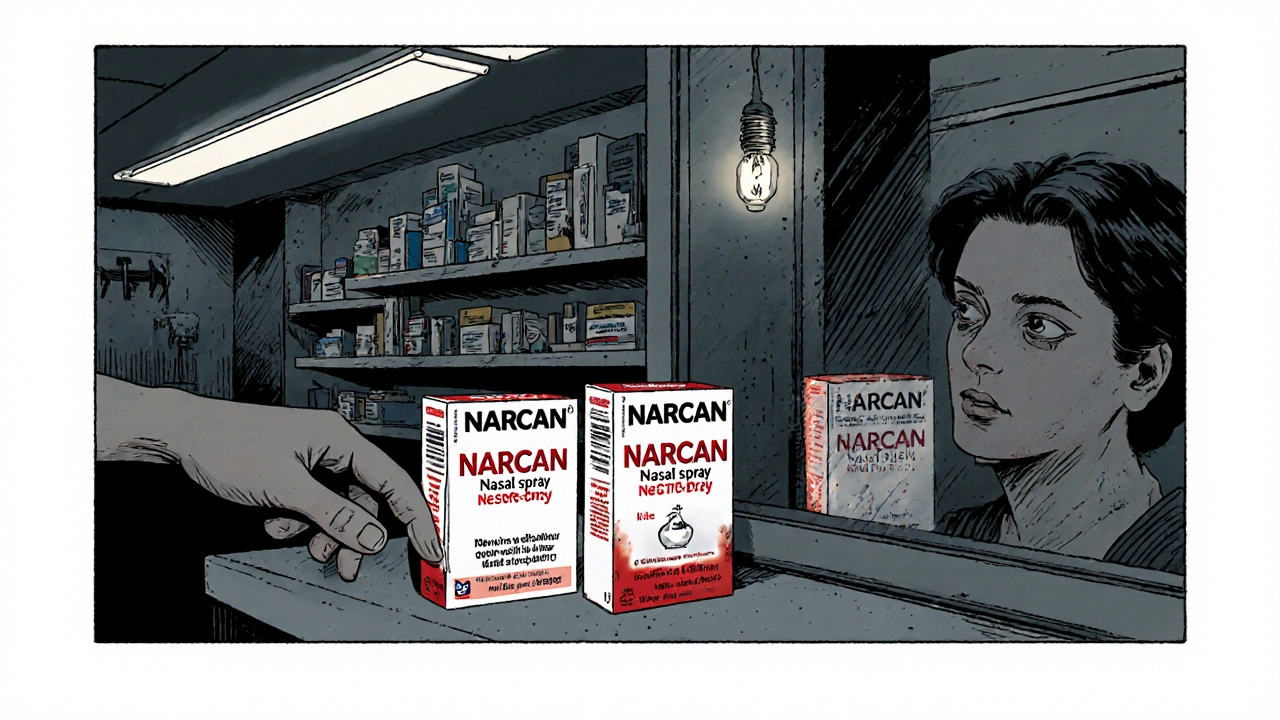
Common Mistakes and How to Avoid Them
- Waiting too long to act. People often think they’re just asleep. If someone won’t wake up and isn’t breathing normally, treat it as an overdose.
- Not pressing the plunger fully. Studies show 18% of first-time users don’t depress the plunger completely. Push until it clicks.
- Using the same nostril twice. Always use the second spray in the opposite nostril. It ensures even delivery.
- Assuming naloxone works on all drugs. It only reverses opioids. It won’t help with alcohol, benzodiazepines, or stimulants like cocaine. But if you’re unsure, give it anyway-it’s safe.
- Leaving the person alone after one spray. Even if they wake up, they can crash again. Stay with them until EMS arrives.
Where to Get Naloxone Nasal Spray
You can buy NARCAN Nasal Spray over the counter at most pharmacies without a prescription. Two sprays usually cost between $45 and $140, depending on the store and insurance. Many community centers, health clinics, and harm reduction organizations give it out for free. If you’re worried about cost, call your local health department or search for free naloxone programs near you. Some states even mail it out for free.
Training and Practice
You don’t need to be a medic to use it. After watching a 3-minute video, 87% of people can use it correctly. But practicing with a training device makes it even easier. Some pharmacies offer free 10-minute demos. If you’re someone who might be around people using opioids-whether a friend, family member, or coworker-take 15 minutes to learn. Keep a spray in your car, your bag, or your home. It’s like having a fire extinguisher: you hope you never need it, but you’re glad it’s there.
Real Stories, Real Impact
One Reddit user shared how they saved their brother using two doses of NARCAN at 8:17 p.m. and 8:20 p.m. He started breathing again at 8:23 p.m. EMS arrived at 8:28 p.m. Another user, a harm reduction worker, reported giving three doses to someone overdosing on fentanyl-with only partial response. Paramedics had to give 400 micrograms intravenously to fully reverse it. These stories show that naloxone saves lives, but it’s not magic. It’s a tool. And tools work best when you know how to use them.
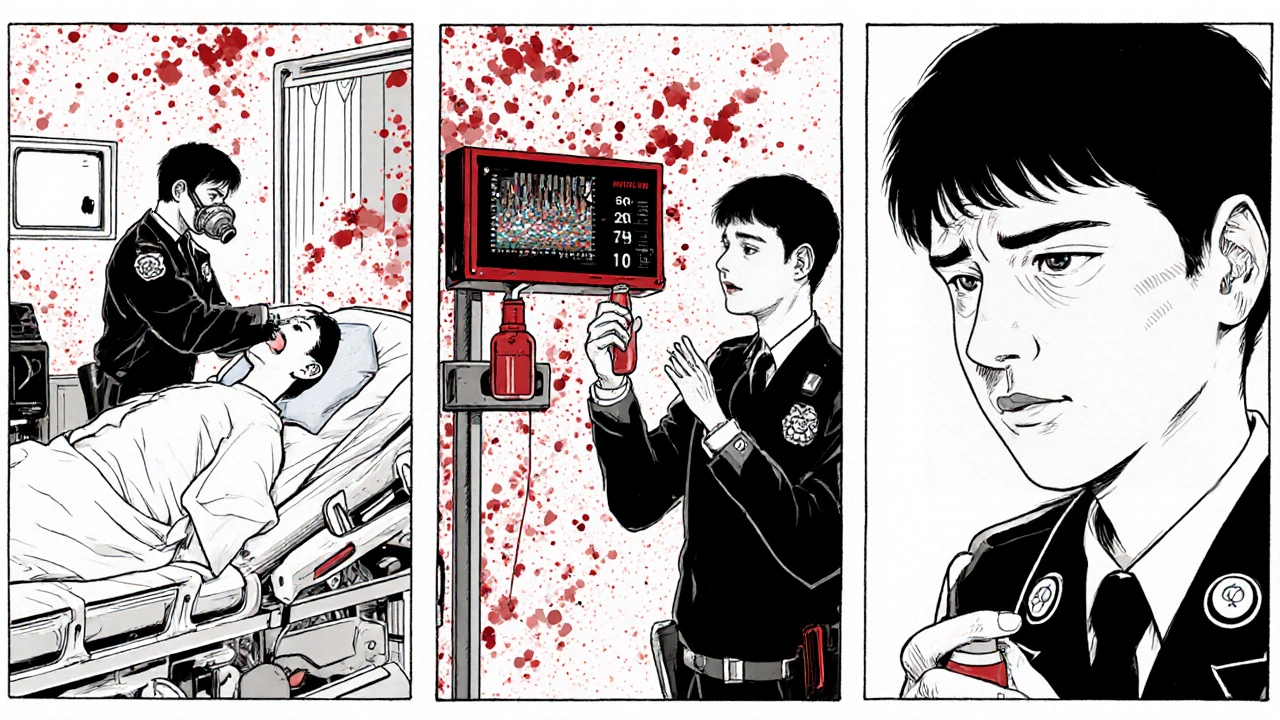
What to Do After a Reversal
After naloxone works, the person may feel sick, anxious, or angry. That’s normal. Naloxone pulls opioids out of their system fast, which can cause sudden withdrawal. Don’t argue with them. Stay calm. Reassure them that help is coming. Don’t let them leave until EMS arrives. Even if they insist they’re fine, they’re not out of danger yet.
Legal Protection
Forty-seven states have Good Samaritan laws that protect people who give naloxone in good faith. You won’t get in trouble for helping. And if you call 911, you’re protected from drug possession charges in most places. These laws exist so people don’t hesitate to act.
What’s Next for Naloxone?
Researchers are already working on longer-lasting versions. One extended-release nasal spray is in clinical trials and could last up to 12 hours. That would mean fewer doses and less risk of rebound overdose. But right now, the 4 mg spray is the most reliable tool we have. And it’s available to you.
Final Thought: You Can Save a Life
You don’t need to be a hero. You just need to know what to do. Keep a naloxone spray handy. Know the steps. Practice if you can. And if you ever see someone not breathing, don’t wait. Act. One spray could be the difference between life and death.

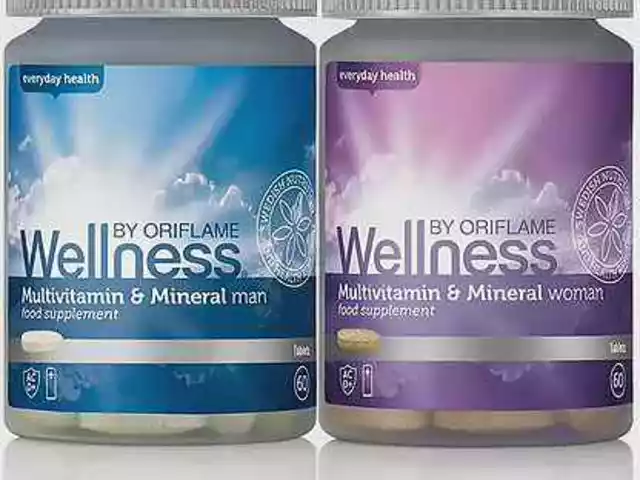
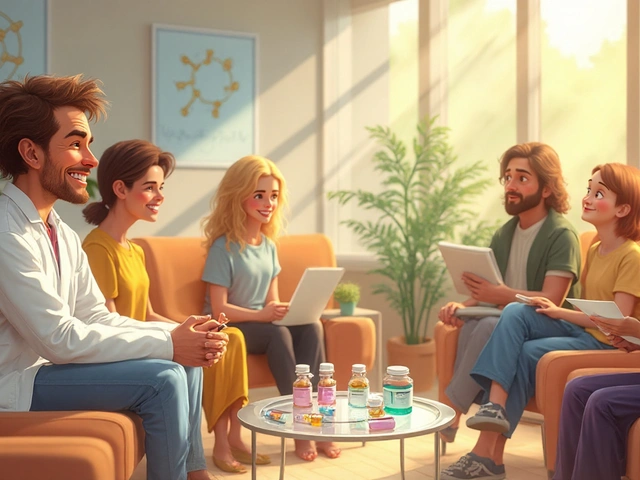

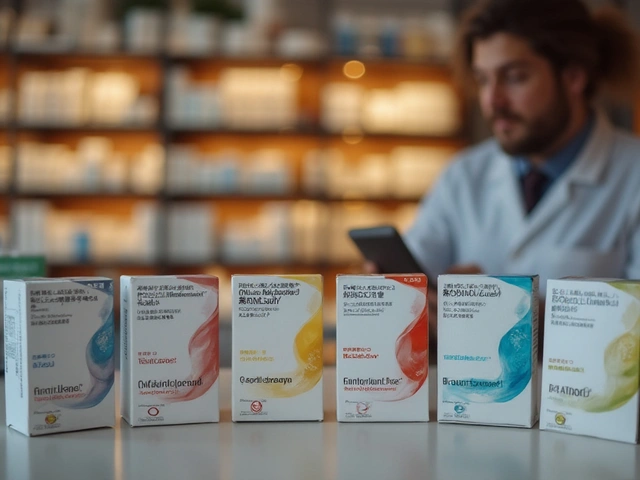
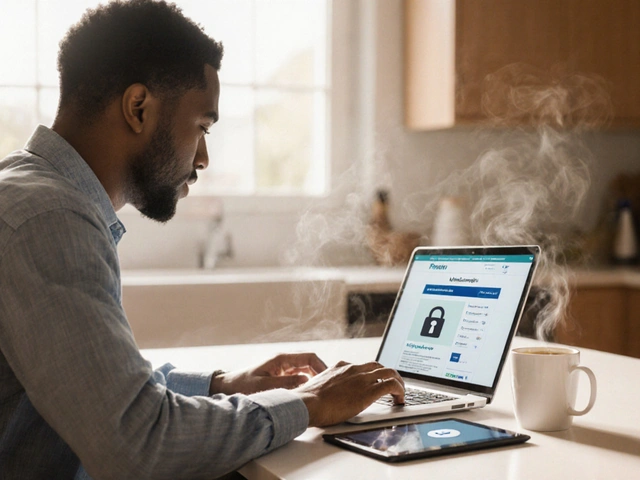
mike tallent
16 November 2025 - 21:15 PM
Just kept a NARCAN in my glovebox since my cousin OD’d last year. 🙏 Got to use it twice-both times, the person woke up within 90 seconds. Don’t overthink it. Spray it, call 911, hold their hand. That’s it. You don’t need to be a medic. You just need to care enough to act.
Matt Wells
17 November 2025 - 05:06 AM
While the intent behind this guide is commendable, the lack of precise terminology regarding pharmacokinetics and receptor binding dynamics undermines its scientific credibility. Naloxone’s affinity for mu-opioid receptors is approximately 100-fold greater than that of morphine, yet the article fails to contextualize this within the broader neuropharmacological framework of opioid antagonism. Furthermore, the assertion that ‘it’s not a cure’ is technically accurate but semantically imprecise-naloxone is a competitive antagonist, not a therapeutic agent.
George Gaitara
19 November 2025 - 00:29 AM
Okay but let’s be real-why are we giving this to everyone like it’s hand sanitizer? Who’s going to be spraying strangers on the subway? And what about the people who *want* to OD? Are we just enabling them now? I mean, I get the heartwarming story vibes, but this feels like society’s way of saying ‘we’re not gonna fix the system, so here’s a nasal spray.’
Also, why is it called NARCAN? Sounds like a brand of energy drink. Who named this? Marketing department?
Deepali Singh
20 November 2025 - 22:22 PM
Statistically, the majority of naloxone administrations occur in non-medical settings, yet the success rate drops significantly when administered by untrained individuals due to improper dosage delivery and delayed EMS activation. The CDC’s 2023 report indicates that only 41% of laypersons administer the second dose within the recommended 3-minute window. Furthermore, the assumption that naloxone is universally effective against fentanyl analogs is misleading-carfentanil, for instance, requires up to 10x the standard dose, which is rarely available to the public. This guide, while well-intentioned, creates a dangerous illusion of efficacy.
Sylvia Clarke
21 November 2025 - 23:41 PM
Look-I’m not a fan of ‘hero culture’ in emergency response, but honestly? This is the kind of thing that turns ordinary people into quiet lifesavers. 🌟
And yes, the fact that you can buy this at CVS next to the gum and condoms is kind of beautiful. Like, we’re finally treating addiction like a public health issue instead of a moral failure.
Also, the part about turning them on their side? That’s the quiet genius of it. No drama. Just practical, human care. Keep the spray. Know the steps. Be the person who doesn’t look away.
Jennifer Howard
22 November 2025 - 17:47 PM
I am deeply concerned about the normalization of opioid use. This guide is essentially handing out a bandaid to a bullet wound and calling it progress. People who use drugs are not victims-they are making poor choices. Why are we spending millions on nasal spray when we could be funding rehabilitation centers? And why are we giving this to minors? What’s next? Free cocaine antidotes? This is not compassion-it is enabling. And it’s wrong.
Abdul Mubeen
24 November 2025 - 11:35 AM
Let me ask you this: who is really behind the push to make naloxone widely available? Is it truly altruism-or is it part of a larger agenda to desensitize society to drug use? The pharmaceutical companies profit from both the opioids and the antidotes. The government promotes this as a ‘public health measure,’ yet the overdose crisis continues to escalate. Coincidence? Or a calculated cycle of dependency? I urge you to research the funding sources behind harm reduction programs. The truth is rarely as simple as ‘just spray it.’
Joyce Genon
25 November 2025 - 15:19 PM
Let’s not pretend this is some revolutionary breakthrough. The fact that we need to hand out naloxone like candy means our entire drug policy is a catastrophic failure. We’ve criminalized addiction for decades, underfunded treatment, allowed pharmaceutical greed to run rampant, and now we’re acting shocked that people are dying? This guide is just a Band-Aid on a hemorrhage. And don’t even get me started on the fact that two doses are often insufficient for fentanyl-yet we’re telling people to ‘just keep spraying’ like it’s a video game power-up. We’re not saving lives-we’re just delaying the inevitable while pretending we’re doing something. The real solution? Decriminalize everything, fund housing and mental health, and stop treating people like problems to be managed with nasal sprays.
Julie Roe
27 November 2025 - 08:28 AM
I’ve trained over 200 people at my community center to use naloxone. Most of them were parents, teachers, librarians-people who never thought they’d need to save someone’s life. One woman told me she kept it in her purse because her son was in recovery, and she said, ‘I’d rather have it and not need it than need it and not have it.’
It’s not about being brave. It’s about being prepared. You don’t have to understand the science. You just have to know how to push the plunger. And if you’re reading this? You’re already one step ahead. Keep one in your car. Keep one in your backpack. Keep one where you work. It’s not about being a hero. It’s about being human.
Eva Vega
27 November 2025 - 11:58 AM
As a pharmacologist, I appreciate the practicality of the guide, but the omission of pharmacokinetic variability in opioid metabolism is a critical flaw. Naloxone’s half-life (30–80 minutes) is significantly shorter than that of fentanyl analogs (up to 200 minutes), making rebound overdose a quantifiable risk. The recommendation to ‘stay with them for 4 hours’ is correct but insufficiently emphasized. Furthermore, the claim that naloxone is ‘safe’ is misleading-it can precipitate acute opioid withdrawal, which in patients with cardiovascular comorbidities can trigger arrhythmias or hypertensive crises. This guide should include a contraindication note for individuals with known cardiac conditions. While accessibility is vital, safety must be framed with clinical rigor, not just optimism.
jalyssa chea
29 November 2025 - 04:45 AM
i just saw someone use this on a guy in the park last week he was blue and i was scared but they sprayed it and he coughed and woke up like magic i cried and then he got mad and yelled at them for waking him up and i dont know what to think anymore
John Wayne
30 November 2025 - 07:18 AM
It’s amusing how this guide treats naloxone as if it’s a universal solution, while ignoring the broader context of societal decay. The real issue isn’t the lack of access to this spray-it’s the collapse of family structures, the erosion of personal responsibility, and the normalization of chemical escape. If we’re going to hand out antidotes, shouldn’t we also hand out accountability? This isn’t medicine. It’s moral surrender dressed in a blue nasal spray.